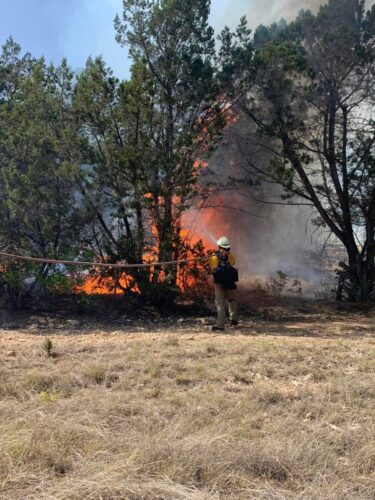National Wildfire Deployments: A POV
September 2, 2022 9:29 am

By Kinner Ingram, DOF Rappahannock Senior Area Forester
As a forester for the Virginia Department of Forestry, our phones go off at all times of the day (and night), and we generally never know who it is, unless it’s a weekend or evening. While calls during work hours are generally coworkers or landowners, calls outside of work hours generally lead to some kind of fire response. Those are the calls that make us stop and take a breath before answering.
In Virginia, we have a fall and a spring fire season, with spring usually being the busier and more intense of the two. That being said, it doesn’t mean that outdoor fires in Virginia are bound by those times; they are after all “wild.” Fall fires happen while the leaves are on the ground and dry, and this season is usually mitigated by hurricane moisture and other systems moving through. The spring fire season runs mid-February through early May. Humidity and rainfall in Virginia are generally at their lowest during this period. Dead, dry leaves from last fall are still on the ground, and new leaves have not yet sprouted on trees to break up winds. These conditions are prime for fast-moving wildfires.
All DOF foresters and technicians respond to wildfires in their local work area but may also be sent anywhere in the state to support suppression efforts. In addition to in-state wildfire suppression, DOF personnel can sign up to travel on out-of-state details. These details generally run around 20 days and can be anywhere in the United States. Sometimes we receive notice a week or two prior to a detail, but other times we find out the day before we deploy.
The detail starts with one of those “take a breath” phone calls. We get our orders (where, when, how), and immediately begin preparing. First up: figuring out how to pack the least we can to sustain ourselves for the detail. If we are driving with a crew to an incident, we may be able to get away with carrying more things because we aren’t bound by air travel restrictions. If we are flying out to the incident, we may be staying in a camp (an area where resources on a fire are staged), so we’ll need to pack for camping while staying under the weight limit. Once things are packed and we’ve arranged to take care of local work matters while we’re gone, we head out.
If traveling by highway, the original group may pick up others as they travel to the destination. Traveling long distances in cramped quarters with folks we’re about to spend 20 days alongside gives us plenty of time to bond. We learn who could (or couldn’t) make it on American Idol, who is competitive (as road games fill time along the road), and who is saving their energy for fires (the napper).
Once we arrive at the base of operations we get an in-briefing. These briefings cover key info such as rules, regulations, local laws, and things that may bite, poke, sting, scratch, or otherwise cause one discomfort, a.ka. the “be on the lookout for list.” At this point, we may have to check equipment in and have it inspected before being released to set up our campsite or hotel room.
What happens next depends on the behavior of wildfires and the weather. If there are lots of fires and dry, windy weather, we may be busy the entire trip. If there’s lots of rain, maybe not so much.
Each morning starts with a briefing, sometimes held standing in a loose circle in the middle of nowhere, sometimes held at a table in an air-conditioned room in a town. The briefing includes a weather forecast, which everyone continually checks throughout the day. (Not officially, but who doesn’t want to know that it’s 113oF in the shade while we are working.)
Safety of personnel in wildland fire suppression is a top priority, so briefings will also include a safety message. Accidents are regularly reviewed to learn what went wrong and how they can be prevented from happening again. Findings from these reviews are used for safety messages like “6 Minutes for Safety,” which are produced by the National Wildfire Coordinating Group (NWCG). The topic of these messages usually rotates, or if there has been a series of accidents related to one thing, that may be emphasized more.
The crew also gets their orders for the day from the briefing, then set out for the business of the day. When on detail at one incident, our orders may be to continue where we left off yesterday, or they may be to head four hours away to provide support on another fire. If the weather is rainy, orders may be to sit tight and wait until things dry out. Either way, we typically stay close to our assigned base, because you never know when something new will start.
This cycle repeats until it’s time to demobilize and head home. The wrap-up process usually starts off with making sure that finance has pay sheets with accurate numbers for hours worked. Then we start the journey back home. If driving back, we re-assume our road trip archetypes of the American Idol winner/loser, the napper, and the ready-to-get-homer (usually me.) If flying, you hope you don’t have any delays or missed flights.
Once you get home, you enjoy time with your loved ones, and then get ready for the next call.
Tags: Emergency Response, Wildfire Suppression
Category: Administration, Fire and Emergency Response



